Susan Maxwell's Blog, page 3
March 1, 2024
Five For Friday #23
In the early Roman calendar, the new year began on the first of March—you can still see the traces of this system in several of the names of September, October, November and December (seventh to tenth months, respectively). I’m very happy to fly the rebel flag for this new-year date: it coincides with the start of (meteorological) Spring, and there is finally the sense of a corner being turned with the lengthening days. Winter has a long tail in Ireland, though, so I won’t be packing up the heavyweight duvet any time soon…
2. Things HeardCover versions
The writer Maura McHugh, in her most recent Splinister newsletter, mentions how much she loves Nina Simone’s cover version of George Harrison’s 'Here Comes the Sun' and this set up an association of ideas.
One of my favourite Nina Simone songs is also a cover version, this time of 'Feelin’ Good' (probably my absolute favourite is the angry live version of her own 'Mississippi Goddam'). 'Feelin’ Good' was written for a musical, The Roar of the Greasepaint—The Smell of the Crowd which, like most musicals, I have not seen. The song was first performed in 1964 by Cy Grant, and it has been covered many times since. This song is unusual for me in that there are not one but two cover versions that I love: Nina Simone’s (on I Put a Spell on You, 1965) and Muse’s (on Origin of Symmetry, 2001).
The association of ideas continued, and I listened for the first time in years to Tori Amos’ remarkable cover of 'Smells Like Teen Spirit' (the original being on Nirvana’s 1991 release, Nevermind, the cover on Amos’ 1992 Crucify album). Finally, after much racking of brains to recall the band’s name, I listened once more to Disturbed’s inspired cover of 'The Sound of Silence', first released in 1964 on Simon and Garfunkel’s debut album Wednesday Morning, 3 a.m. Disturbed released their version in 2015.
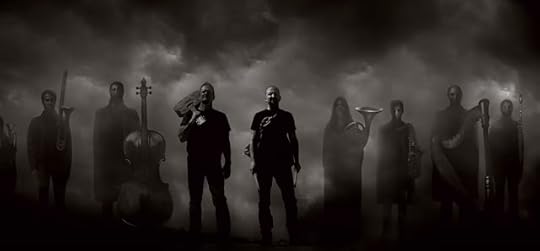
3. Things Seen Through the WindowSnow! Sneeuw! Sneachta! For the first time this season in our neck of the woods!
"The word [sneachta] derives from the Indo-European root *snei̯gʷʰ- which means… [i]n most IE languages … 'to snow'… In Old Irish the verb snigid < *snigʷʰi̯eti refers to the motion characteristic of rain, rivers, blood, juice, sand etc. i.e. "to flow, pour, drip", as does its verbal noun snige. … If you want to say "it snows" in OIr., you have to say snigid snechtae 'snow flows'."
To find out why this might be the case, you have to read the entire thread by David Stifter on Bluesky or Twitter. Fascinating, as always.
I have a problem, which is by no means unique to me, but suffered by bibliophiles the world over: Ex Occidente/Mount Abraxas tastes inexplicably paired with a fire sale budget. I occasionally attain the giddy heights of giving or receiving a book from the excellent Swan River Press as a gift, but that’s as close as it gets. And not a few small presses are placed even further out of bounds because they are located in North America or post-Brexit Britain, so shipping and customs charges pile Pelion on Ossa.
A light in this gloom is shone by Tartarus Press, which—a rare instance—has a reasonable selection of its list available as e-books. In fact, some are available as reasonably priced paperbacks, a truly appealing option, but… Brexit. I have just finished The Collected Connoisseur by Mark Valentine and John Howard, which was a real pleasure: beautifully written, and atmospherically evoking certain strands of weird/decadent literature of an age that, while earlier, will never be bygone to its aficionados. Tartarus have just reprinted their hardback editions of Machen’s The Hills of Dreams and The House of Souls.
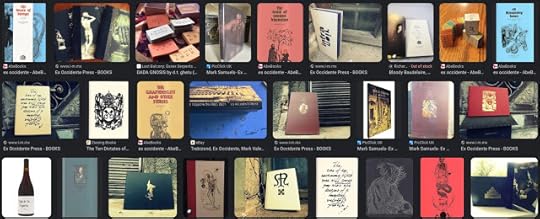 I can still press my nose up against the sweet-shop window...
I can still press my nose up against the sweet-shop window...5. Things ReadA lyrical, elegiac article by Doug Muir on Crooked Timber about our intrepid emissary to outer space.
"There’s no way to pack the whole story of Voyager 1 into a single blog post. Here’s the TLDR: Voyager was the second spacecraft to fly past Jupiter, and the first to take close-up photos of Jupiter’s moons. It flew on past Saturn, and examined Saturn’s moon Titan, the only moon with an atmosphere. And then it flew onwards, on and on, for another forty years. It officially left the Solar System and entered interstellar space in 2012. It just kept going, further and further into the infinite emptiness."
I'm not given to emotional responses where human beings are concerned (unless that emotion is grumpiness), but thinking about Voyager has occasionally resulted in my specs misting up… must be a glitch in my OS.

February 23, 2024
Five For Friday #22
Expatiate (on or upon): enlarge upon (e.g., a theme or topic), in discourse, argument, or writing.
Clagairt + 35 more: rain.
The first of these I came upon through reading Henry James and Queer Modernity.
The second was discovered on a short detour down a rabbit-hole. While writing a review of Manchán Magan’s Thirty-Two Words for Field, I recalled the cliché about Inuit having an unusually large number of words for snow (some of which appear in one of my favourite books, Miss Smilla’s Feeling for Snow). Assuming that Irish must have a reasonable number of words for rain, I found a 2006 article in the Irish Times providing no fewer than thirty-six of them, listed by Breandán Ó Cróinín. We’ve had need of all thirty-six of them so far this month: showery weather, light sprinkles, downpours, the lot.
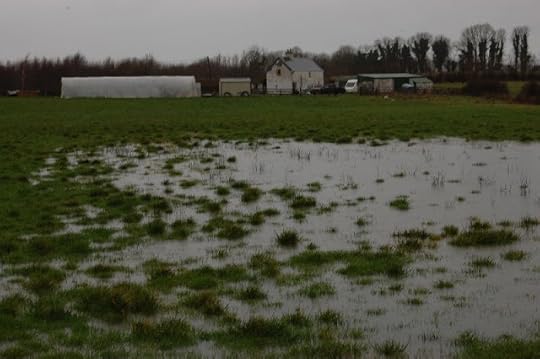 Eyewitness footage of some of the 36 types of Irish rain that fell in 2018 2. Things Discovered: FolkloreA legend about St. Patrick
Eyewitness footage of some of the 36 types of Irish rain that fell in 2018 2. Things Discovered: FolkloreA legend about St. PatrickDoing a little research for the next WIP, I took out a book of Laois Folk Tales (Nuala Hayes), which I had glanced through but never read. In the chapter 'Four Saints and the Book of Leinster', I came across a tale of St. Patrick; it is the sort of story I always find attractive because of the casual mix of Christianity and paganism.
The way that folklore and religion could sometimes blend confused me in my youth; I recall hearing stories (in school) ostensibly about, for example, the Virgin Mary where she interacts with St. Bridget. Why, I asked myself, was St. Bridget hoofing it about in the Middle East and how was she a saint before Christ was born?
Anyway, in this story, St. Patrick is on his way from Kilkenny into Munster. He had to cross part of Laois, and was not well received; the locals threw stones at him. He cursed them (very clearly: “I curse Uí Duachi,” the place in question) three times, with the result that even now the wind demolishes haystacks, the tops of the rushes wither, and the River Dinen is "subject to devastating floods." Laying curses just does not seem a terribly… episcopal… approach to the flock.
Another thing I came across in this book: I did not know that the Book of Leinster came from Stradbally, and used to be in the possession of Rory O’More.3. Things Curious (and Enticing) Cré na Cille, an Irish-language absurdist novel.
I came across this a few weeks ago and, even better for a non-speaker of Irish, not one but two recent translations into English.
Cré na Cille was written in 1949 by Máirtín Ó Cadhain (1906-1970) and published by Sairséal agus Dill, but it was not translated in English until 2015 (as The Dirty Dust) by Alan Titley (who recently translated the Táin Bó Cúailnge for Little Island). and as Graveyard Clay in 2016 by Liam Mac Con Iomaire and Tim Robinson.
The book is composed of internal monologues of, and dialogues between, the dead in a particular graveyard, and Ó Cadhain wrote it in the Connemara Irish that he spoke himself, the vernacular ‘speech of the people’ where he lived, and the characters are violent, jealous, and petty.
The two translations use quite different language, and it is difficult, if you are relying heavily on a dictionary, to know which is the more ‘correct’, especially when it comes to invective and strong language. Titley’s language is much earthier (“Fuck them if they…”, “…and then the bullshit…”) compared to Mac Con Iomaire (“Did the devil possess them to…”, “…and the song and dance…”). Apparently, Cré na Cille was translated not only into English, but German, Dutch, and Czech as well.
I have not got very far in the book, as I am also reading for a journal article, as well as Lispector’s Hour of the Star, but happily Cré na Cille is a very, very long way from Peig (though possibly the uncensored Peig Sayers might have been a bit more Ó Cadhain…)
4. Things ReadWhy writers write: A Q&A with Neil Gaiman.
Here at BdR, we have been preparing a media pack, which will contain a Q&A sheet. As a member of ALLi, I had plenty of resources to hand, including sample questions. It was a great help, but, alas! fell short of spoon-feeding me with sample answers, which meant I had to think hard about a few things.
One of the questions was about when I decided I wanted to be a writer. It’s a difficult one to answer, particularly because when I was very young, I was more likely to draw than to write, and it wasn't easy to pin down a turning point. In search of inspiration, I checked out a few other writers and what they had to say about their formative years, and came across Neil Gaiman’s enthusiasm for The Voyage of the Dawn Treader, which is also one of my favourite Narnia books.
Gaiman also named Lud-in-the-Mist as the book he wished he had written (I love it, and also his introduction to it) and A Humument as the book he gives as a gift; the very same book I received as a gift two Christmases ago, although not from Neil Gaiman which would have been, frankly, weird (though wonderful).
5. Things SeenA Perspective study of staircases by Hans Vredeman de Vries (via Dr. Peter Paul Rubens).I Spotted this in my Twitter feed, and it caught my attention because my imminently forthcoming novel A Wild Goose Hunt (shameless plug!) features a room reached by means of a vertiginous and disorienting series of stairways. To think, if only Hans had gone that extra mile and put in a few more flights of stairs, he might have landed a book illustration gig…
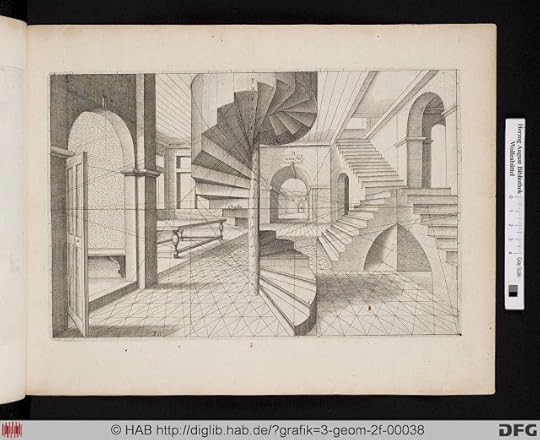 via Europeana
via EuropeanaFebruary 16, 2024
Five For Friday #21
It's been a bit of a dislocated week for me: I had to go on an expedition into the office for a couple of days, which completely threw my working-from-home schedule out of whack, and I don't do change very well. So I haven't been keeping up with the online world around me as I should, instead recovering from all of that being in the company of Other People and crowded public transport etc etc. Which is a long-winded way of saying that I don't have a Five For Friday blog post prepared. So I've dredged up five photos of me doing non-authorly, smallhold-y things around the place. I've got a lot of hidden talents, you see—only, if you know where they're hidden, perhaps you could let me know?
1. Planting stuffThis was in the early days, when we were growing produce outside as well as in the polytunnels. We scaled back a couple of years ago to focus on other projects, but have plans for the future…

2. Harvesting stuff. Iconic rural photo #1: sturdy peasant edition.
You can't plant veg in the pouring rain, but if you're supposed to be selling them in a few hours time, you don't have much choice about harvesting conditions.
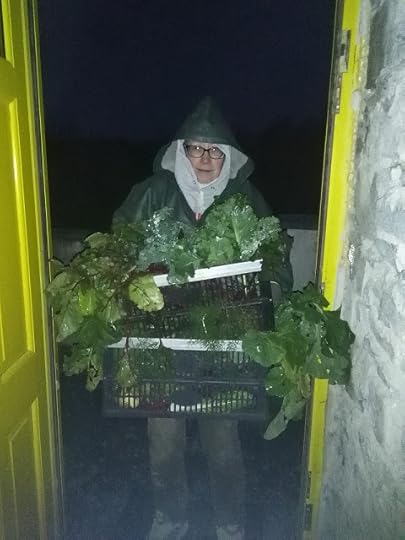
3. Misty morning. Iconic rural photo #2: folk horror edition.
I think this is my favourite landscape photo from the hundreds we've taken. The lovely warm ones with glowing rainbows and wild flowers and such are all very well, but they're far too wholesome.
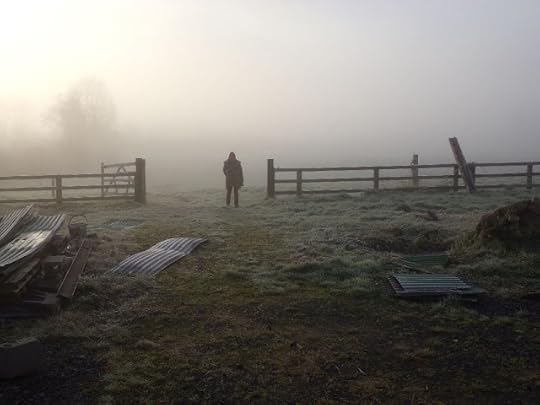
4. Tractor!!!
Here I am, taking Harrison the Ford out for a spot of work. Or Harrison is taking me. It's not always easy to know who is calling the shots.
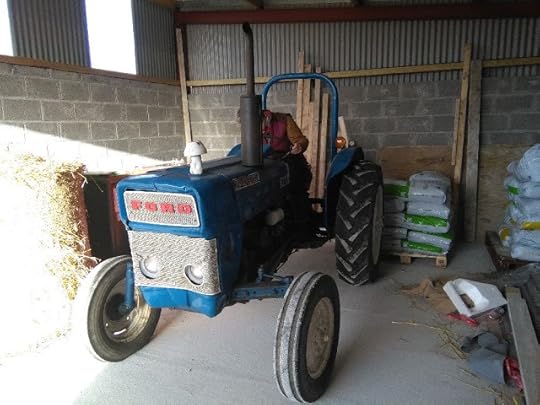
5. The Dog from Next Door
When we arrived, we discovered that the land was actually someone else's territory; she came around each day to make sure that the peasants were behaving themselves, and to dispense hugs. A truly beautiful person, who now runs free in the Elysian fields. She was a bit cracked: that's how the light got out.
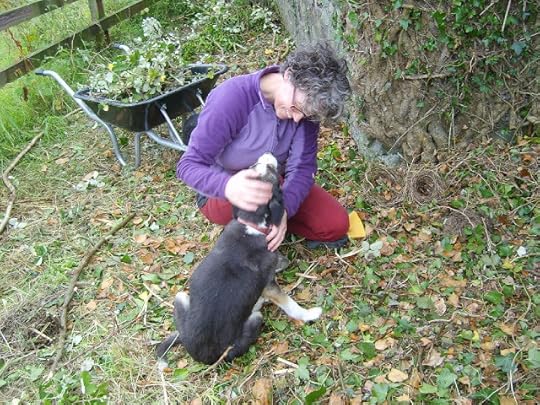
February 9, 2024
Five For Friday #20
Riffle: groove or slat in a sluice to catch particles of ore
Epinosic: unwholesome, unhealthy.
2. Things Discovered: ScienceThe Carrington Event
Stanza: I did not know that ‘stanza’ originally meant room, or halting place, until I started reading Lee Upton’s Defensive Measures on the poetry of Gluck, Carson, Bishop, and Niedecker. Upton was writing about the ‘condensing language’ of poetry, and the associated ‘illusion of interiority’.Stanza segreta di Michelangelo (Musei del Bargello)
Doing a little research previously while planning what follows on from an event in Wild Goose Hunt (that’s what’s known as a heads-up), I came across the Carrington Event, of which I had never heard.
It was a very intense electromagnetic storm in September 1859 that caused unusually strong aurora, and damage to telegraph stations, and is thought to have been the result of a strong solar flare.
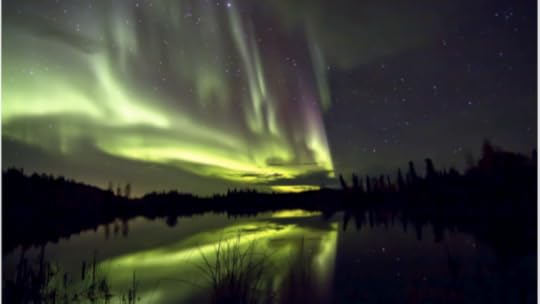 Geomagnetic Storm Aurora (noaa.gov)
Geomagnetic Storm Aurora (noaa.gov)And lo! Apparently there was a solar flare from an 'unstable' sunspot, that caused radio blackouts across Southeast Asia and in Australia, on February 5th (Eastern Standard Time). I'll really have to start being a bit more responsible about what I put into books…
3. Things to be Read The works of Japanese author Edogawa Ranpo (Tarō Hirai), brought to my attention in a blog post by Marina Sofia.
"Edogawa was a great fan of Edgar Allan Poe, Conan-Doyle and Arsene Lupin and, although he was not the first Japanese writer of mysteries, he certainly was one of the best known in his heyday, a key figure in developing mystery and thriller writing in Japan."
The blog post is about the book The Black Lizard and its film adaptations, but
"if you want to read a more genuinely unsettling story and get a feel for Edogawa’s talent, I’d recommend Beast in the Shadows, which has also been reissued recently by Penguin."
4. Things ReadHow to kill a God: Christians against Pagans in the Middle Ages. A blog post from Medievalists.net
"During the Middle Ages, Christians were expanding their religion into every corner of Europe. To bring new lands under Roman Catholicism, the old pagan faiths had to be destroyed. Here is how this was done on the island of Rügen in the twelfth century."
I have had a fascination, from the time I was quite young, with the boundaries between things, especially where the boundaries are intangible, like the boundary between one townland, or country, and another; or, like cultural transformations, are slow and subtle.
Being also reasonably literal in my expectations, I struggled when little with the idea of ‘gradual transformation’ rather than ‘hard border,’ no matter how patient the parental explanation.
5. Things HeardFabula Celtica: A Celtic Studies Podcast. (Brought to my attention by David Stifter, if memory serves me well.)
Since those of my books set in the Hibernia Altera universe draw heavily on (or shamelessly pillage) Irish myth, I am always interested to find out more. As a great deal of what is written about ancient Ireland and anything labelled ‘Celtic’ lies more in the realms of fancy than of fact, one must be forever vigilant.
The past few months, however, have seen the launch of not one but two podcasts relating to Irish myth and history with reassuringly scholarly credentials. I’ve finally got around to catching up, and listened this week to the opening episode of Fabula Celtica:
"A general Celtic Studies podcast based out of Ireland. We cover various topics organised into thematic series. Hosted by Tyler Baxter (MA Celtic Studies, PDip in Ancient and Medieval Languages) and Kevin Collins (the tech guy with a Cork accent). The podcast aims to be accessible to general audiences, blending storytelling and scholarship."
The episode took as its starting point the Lebor Gabála Érenn (Leabhar Gabhála Éireann / Book of Invasions), and is a fine general introduction to the topic. I’ll be back!
(I will have a listen to the second of the two podcasts mentioned above, in time for next Friday’s miscellany.)
February 2, 2024
Five For Friday #19
1. Things WatchedEamon Morrissey's monologues from works of Flann O'Brien
In writing a review of Sean Ashton's The Way to Work, I referenced Flann O’Brien’s third policeman’s exposition of his theory about bicycle mollycules. I had a vague recollection of seeing Eamon Morrissey on the television many years ago, performing monologues as The Brother, a regular character in O'Brien's 'Myles na gCopaleen' weekly column in the Irish Times.
So I summoned up The Brother on YouTube, and watched Morrissey’s recital of that paean to porter, 'A Pint of Plain', and his account of exciting times cow-punching in Ringsend with Slug Willard and Shorty Andrews (from the novel At Swim Two Birds rather than the newspaper column). I followed this up with his frankly sinister performance as the third policeman, expounding the atomic theory as it pertained to bicycles and horses.

2. Things execrated The Big Four , an episode of ITV's Poirot series
This is one of the worst adaptations of an Agatha Christie story I have seen, certainly the worst of the Poirot series, which for much of its run was reasonably faithful to the text.
The original novel is not one of Christie’s best (a gang of international provocateurs in pursuit of a grand goal of world domination), sliding as it does up and down the thriller-mystery scale between Bulldog Drummond and Sax Rhomer. The adaptation, though, is on a par with the previous holder of the golden raspberry, At Bertram’s Hotel (again an ITV production, this time from a Miss Marple book), but for the opposite reason.
ABH was trash because it added a whole lot of unnecessary and occasionally bizarre details. TBF was as bad, but because it took out everything that might have constituted a storyline at all. There was no detecting to speak of, there was nothing left of the original plot except its unbelievability, and the invented motive was feeble. Hastings came all the way back from South America just to say “Good Lord!” or “We have to do something, Japp! And if you won’t, I will!” and then storm out, disappearing until the action, such as it was, was over and it was time for champers and smiles all around.
3. Things historicalA 107-year-old man talks about the changes in farming
Living in the sticks on a smallholding, I am the proud owner of a vintage tractor. My notion of farming in 'the old days' is as it was in the days when Harrison the Ford was a shiny new state-of-the-art tractor straight off the 1970 production line. But 'old' is a moveable feast…
It was fascinating to watch a 1965 RTE television interview with Michael Fitzpatrick (b. 1858). Living in Maynooth at the time of the interview, he was originally from Clare, where he witnessed the notorious Bodyke Evictions, and knew a man who would not use a mechanical reaper and binder, preferring to pay workers for the job.
4. Things brought to mindA post on New Age shops from the Wormwoodiana blog
New Age shops have not, of course, gone away, but they are nonetheless always associated in my mind with a period of life when I was marginally (let us say) younger than I am now. Those heady days of striking out on one's own in a series of gradually less Withnail-and-I-esque bedsits or flat-shares, everything on the cheap. It was not that I haunted the New Age shops in those days, more that they always seemed to inhabit the same dingy shopping arcades where one went to find second-hand books and the 'alternative' or 'exotic' clothes, rickety furniture and artefacts that signalled entry into this new, independent phase.
Mark Valentine notes, in his nostalgic and informative blog post, that
it was a notable New Age shop, Gothic Image in Glastonbury, that introduced me to a sheaf of pagan, Celtic, antiquarian and alternative magazines: Pendragon, Caerdroia, Wood & Water, Sangraal and so on, opening up a world which reminded me of the fiction of Machen and Blackwood and Fortune.
Valentine was a far more serious bookworm of the weird and esoteric than I was at that stage; I did not pay much attention to the books in the shops that I came across and occasionally ventured into. Even so, I somehow doubt that they matched the quality or range of those found in Gothic Image.
5. Things supportedA Kickstarter for a translated anthology of Gujerati pulp fiction.
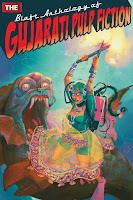 Scrolling down through the social media feeds, my attention was caught by a post from the Chennai-based Blaft Publications urging readers to contribute to their crowdfunding campaign to produce this anthology. Gujerati is spoken by about 70 million people and has a thriving literature. While the 'big names' have been translated (Gandhi, for instance),
Scrolling down through the social media feeds, my attention was caught by a post from the Chennai-based Blaft Publications urging readers to contribute to their crowdfunding campaign to produce this anthology. Gujerati is spoken by about 70 million people and has a thriving literature. While the 'big names' have been translated (Gandhi, for instance),there's a universe of much pulpier Gujarati books that have never been translated: action and adventure novels, crime thrillers, ghost stories, science fiction, and racy underworld revenge fantasies. The authors who work in these genres are some of the best-selling writers in the language, but their work has never been available to English readers before.
One of my persistent good intentions is to fish in non-Anglophone ponds and read more works in translation. And not just high-falutin' literature, either: so how could I resist making a small contribution to this project?
Website
January 29, 2024
Two Short Story Reviews
I have been wrapping up some reviews of books I read over the past few months (you can find my reviews here), but I have also done some appropriately short reviews of short stories that took my fancy. Here's a couple of them.
J.A. Prentice: Fruit of the Memory Tree (Beneath Ceaseless Skies Issue #383, June 1, 2023)
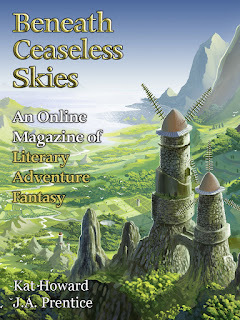 There is an interesting premise to this story: two children (in an unspecified place and era) steal and eat the fruit of their society’s memory tree, and they find out how literally their Keeper keeps the memories of the dead, over thousands of years. There is a grain of kinship with the story of the Garden of Eden, in that the children’s precipitous theft has transformative consequences, their lives are overturned by eating the fruit of this kind of knowledge. The knowledge is of neither good nor evil, but of everything that once was experienced. The overly archaic language is sometimes a little trying, and the prose sometimes feels a little slack—“sweet it was, like honey”—but overall it is well-done, and the impressionistic description of the protagonists’ experiences once the fruit has been consumed is effectively done.
There is an interesting premise to this story: two children (in an unspecified place and era) steal and eat the fruit of their society’s memory tree, and they find out how literally their Keeper keeps the memories of the dead, over thousands of years. There is a grain of kinship with the story of the Garden of Eden, in that the children’s precipitous theft has transformative consequences, their lives are overturned by eating the fruit of this kind of knowledge. The knowledge is of neither good nor evil, but of everything that once was experienced. The overly archaic language is sometimes a little trying, and the prose sometimes feels a little slack—“sweet it was, like honey”—but overall it is well-done, and the impressionistic description of the protagonists’ experiences once the fruit has been consumed is effectively done. Delilah S. Dawson: Blank Space (Uncanny Magazine Issue 51)
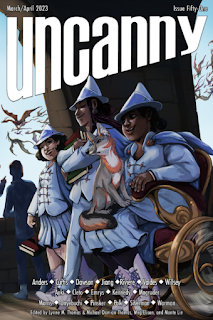 This is a fun, compact, sinister story: a sociopathic slant on a very familiar small-town-noir trope. A young woman, Hailey, is apparently alone in the world apart from her uncle. Working in his store, she is hit on by the local bad boy, a tattooed young buck named Dylan that her uncle warns her against. Dylan has an instinct for which “cute little thing” he can charm and exploit, and his veneer of Gothic rakishness quickly flakes away to reveal the essentially unchallenging, but tawdry, even squalid, reality. Alas for Dylan, there is a reason Hailey is alone.
This is a fun, compact, sinister story: a sociopathic slant on a very familiar small-town-noir trope. A young woman, Hailey, is apparently alone in the world apart from her uncle. Working in his store, she is hit on by the local bad boy, a tattooed young buck named Dylan that her uncle warns her against. Dylan has an instinct for which “cute little thing” he can charm and exploit, and his veneer of Gothic rakishness quickly flakes away to reveal the essentially unchallenging, but tawdry, even squalid, reality. Alas for Dylan, there is a reason Hailey is alone.
January 26, 2024
Five For Friday #18
This week, I came across:
marcescence: the withering but persistence of plant organs (such as leaves) that are usually shed; I think hornbeam does this;
ruderal: used of a plant growing in wasteland, or among rubbish, plants that are the first to colonize disturbed ground;
temerarious: reckless, rash;
pristine: not meaning clean, as I thought, but ancient, original.

2. Things WatchedThis year's first episode of Emma Newman's Tea and Sanctuary podcast
One of the most delightful aspects of the run-up to Christmas were the bite-sized episodes of the Tea and Sanctuary advent calendar series. So naturally, I came back for more when the new season of the podcast proper kicked off
Join author Emma Newman for a cosy chat over a nice cup of tea. In this episode, Emma talks about a little adventure with her grandmother, the Blind Boy podcast, Baileys, the TV show Sharpe and Kim Stanley Robinson's 'The Ministry For the Future'. She also mentions her short story collection 'Before, After, Alone'.
In a new departure for the podcast, it went out in video as well as audio format, so I watched in on YouTube.
3. Things Read 1
An article relating to Flann O'Brien by Stan Erraught.
I was directed to Stan Erraught’s article in the Irish University Review on ‘silent music’ in works of Flann O'Brien and Ralph Cusack by a tweet from the International Flann O’Brien Society highlighting temporarily open-access articles. (I rather like the idea of there being an International Flann O’Brien to go with the Irish-based one.).
In this article, I explore two quite different descriptions of this kind of experience as set out in two mid-twentieth-century Irish novels. In one, Flann O'Brien's The Third Policeman, the narrator watches one of the titular sergeants enjoy music that he – the narrator – cannot hear. In the second, Ralph Cusack's Cadenza, the narrator watches as a village priest mimes playing the piano on a café table, a performance he ‘hears’ and appreciates.
This also meant that I came across another work from an Irish author I did not know, Ralph Cusack (1912–1965); Cusack was a painter, but wrote one book, a memoir. Erraught calls it a “surreal, absurdist work” and the Dictionary of Irish Biography calls it ‘unorthodox’. From the sound of it, this means ‘mad as a box of hair’, so I do look forward to giving Cadenza a whirl.
Also according to the DIB, Cusack once chased out of his house the critic Herbert Read for having criticized Chagall’s work. The writer Henry Reed—author of my favourite radio plays—was often mistaken for Herbert Read, causing Reed to name the main character of his plays 'Herbert Reeve', and have the other characters constantly get the name wrong.
4. Things SeenThe works of the printmaker Laurie Rudling, brought to my attention by a tweet by Brigit Strawbridge.
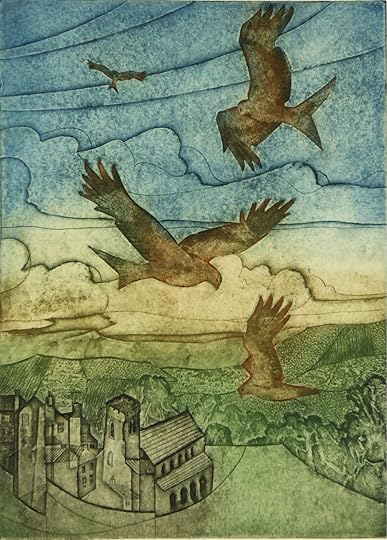 I have always been interested in prints as an art-form, though I have never tried making them myself. When I worked in Newcastle upon Tyne, I frequently visited the Biscuit Factory art gallery, which featured the work of many print artists. The work of several of the northern artists I saw on display in the gallery had similarities with that of the Norfolk-based Rudling, who says of his art
I have always been interested in prints as an art-form, though I have never tried making them myself. When I worked in Newcastle upon Tyne, I frequently visited the Biscuit Factory art gallery, which featured the work of many print artists. The work of several of the northern artists I saw on display in the gallery had similarities with that of the Norfolk-based Rudling, who says of his artMy work is divided between intricately drawn highly technical two plate copper etchings of landscape and richly collaged textured plates producing collagraphs prints of mysterious architectural spaces or abstracted bird forms cubistically interweaved with the landscape in which they fly.
My sister, a more consistent and dedicated artist than I could ever aspire to be, has taken up print-making with a vengeance in the past couple of years; I think I might start pestering her for tutorials…
It has become customary at home that Thursday nights are dedicated to sitting in front of the fire (comfortingly ablaze in season) and reading aloud from a suitable novel or collection of short stories. These are generally works of the uncanny or of mystery, and belonging or harking back to an earlier age; they are accompanied by hot chocolate, brewed to a recipe that it would be death to divulge.
We are currently making our way through The Collected Connoisseur: last night's stories were not the first I have read from this collection, but are strong favourites so far. 'Sea Citadels' references the shipping news, which will never fail to charm, while 'The Prince of Barlocco' was set on a remote island and involved chthonic mystery, and postage stamps. Brief reviews to come soon: advance tl;dr ‘those were really good.’
January 22, 2024
Short Stories 3: The Meaning of Frogs
I am currently running a bit of a promotion for my short story collection Fluctuation in Disorder, so it seemed like a good idea to do the next post in the series taking a brief look at each story. (The stories are all available individually at €/£/$0.99 if you want a bite-sized sample rather than the whole collection.)
But getting back to that promotion: the e-book version of Fluctuation in Disorder is available from Smashwords at a 50% discount until Pancake Tuesday, so you might be tempted to go for the whole stack rather than the single literary pancakes…
The Meaning of FrogsV finds a frog's corpse while taking a disconcerting walk along the seashore. This discovery proves strangely disruptive to her reliance on work for meaning, as she finds herself diverted into providing a 'funeral' for the deceased amphibian. An experimental story, that formally draws heavily on both visual art and music.
V works in a bureaucratic organisation, and when attending a conference, her assured world comes unexpectedly into proximity with the potential for other ways of being. V is on a border—my favourite place for characters—between a state of being where she accepted things as they appeared to be, and a state of being where, however she may decide to act, she knows that the acceptance is a choice, and the appearance is constructed, not natural. The yes creates one circumstance, one reality, the no creates another; V compares this process of acceptance or rejection to the myth that a bear licks its formless cub into the proper shape for a bear.
Like 'Hallowtide Boar', this story was influenced structurally by a piece of music—in this case, Nielsen’s 5th Symphony. This piece was especially attractive for two reasons. One was that it has what the New York Times called a “craggy profile”, because it has so many “false climaxes”, and I was trying to find a new way to present a narrative. The other was the disruptive role for the drum, what the Guardian described as “a battle between the orchestra and the renegade side-drummer”, and in this I saw resonances with V’s repeatedly disrupted relationship with her ordered life within a system of things—demands of her job, the corporate environment—that had previously ordered it.
I listened several times to the drummer’s improvised musical assault when I was writing the last scene of the story. Unlike the drummer, who is, in the final bars, “silenced by the full forces of his colleagues” in the orchestra, V is not (necessarily) re-absorbed into her accustomed way of living. She remains in a state of oscillation, between the varying consequences of yes and no.
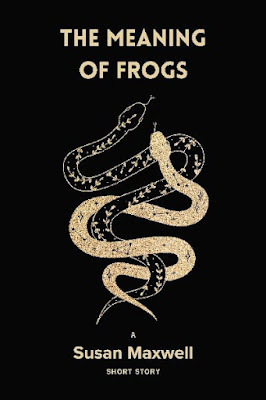 books2read.com/b/MeaningFrogs
books2read.com/b/MeaningFrogs
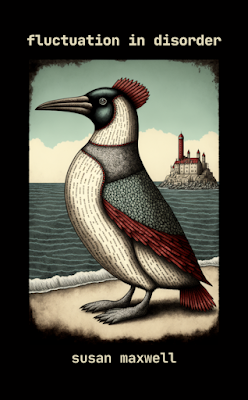 https://books2read.com/fid
https://books2read.com/fidWebsite
January 19, 2024
Five For Friday #17
I found Shaelin Bishop's channel randomly, when looking for guidance particularly in relation to writing characters and dialogue, as what I write tends not to be very character-driven. The videos are fairly short, 15–20 minutes long, and are focused on a single topic, making them very effective. Shaelin is a clear and engaging speaker, her examples are very practical and well-informed, and she had some exercises for developing character that I found very useful.
I have not read any of her work, but it’s all here if you want to have a look.
2. Things from the ArchiverseThe Magnus Archives podcast
It’s horror. It’s archivists investigating a neglected collection of statements about strange happenings. It’s looking into the archives and finding that the archives is looking back. The premise of the podcast is that each episode is a recording of the archivist in the Magnus Institute, talking about case files related to ‘weird or esoteric’ events.
Individually, [the cases] are unsettling. Together they begin to form a picture that is truly horrifying…
I’ve started, as you do, at Season One, where the archivist, Jonathan Sims, is a new recruit, because the last archivist died, leaving ‘a complete mess of an archives’. What’s not to love?
3. Things Read
A post on the Wyrd Britain blog about a radio dramatisation of John Wyndham's The Kraken Wakes.
I have a deep and longstanding fondness for radio, and radio dramas in particular. Part of it is the magic involved in conjuring up a whole world through sound, often by the most basic means, in a small studio.
This BBC Radio 4 adaptation of John Wyndham's alien invasion / monsters from the deep / ecological disaster classic was made in 1998 but sounds far, far older which is testament to the care of the creators but does give it quite a dated feel.
For me, that 'dated feel' enhances rather than diminishes the prospect of listening to this dramatisation.
4. Things SeenTwo documentaries about Edward James, brought to my attention by a blog post from John Coulthart.
Edward James was an important figure in the history of Surrealism, keeping various artists afloat by buying their work (in the process amassing the largest personal collection of Surrealist art in the world). The documentaries, by Patrick Boyle with George Melly in 1978 and by Avery Danziger and Sarah Stein in 1995, chart the progress of
James’s charmed life, from gilded youth as an aristocrat and inheritor of vast wealth, to his old age as “Uncle Edward”, a benevolent eccentric living in the Mexican jungle at Xilitla where he spent many years constructing his own work of art, the concrete fantasia known as Las Pozas.
(I had intended to watch these as a double bill, but the need to crack on with pressing apples to make cider before the apples gave up the ghost entirely meant that the evenings were curtailed, and the Danziger and Stein film will have to wait till the weekend.)
5. Things ReceivedThe other day, I went out to the yard after clocking off from the day job, and was confronted with an object that had appeared as mysteriously and portentously as the monolith in 2001: A Space Odyssey.
We certainly had not ordered a trailer of logs, and a trip to Next Door established that it had nothing to do with them either. Clearly, someone had got the address wrong, and was probably at that very moment fielding an irate call from the intended recipient.
But no—a text message came later in the evening from a neighbour up the road, who had felled a diseased ash tree and had brought us up a load of the logs 'because it was so cold' (it was; it is). This is the sort of lovely, understated, eminently practical generosity and kindness we have come to know from living down the country: even solitary, curmudgeonly, oddball writers are looked out for and looked after as part of the glue that holds rural communities together. We were very touched. And blissfully warm.
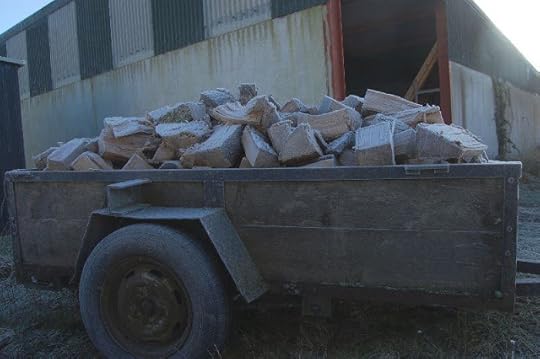
January 15, 2024
On First Looking into Hope Mirrlees' 'Madeleine'
 Hope Mirrlees in 1931 (Wikimedia Commons)
Hope Mirrlees in 1931 (Wikimedia Commons)A couple of years ago, I read Lud-In-The-Mist (prompted, I confess, by a reviewer comparing Good Red Herring to Hope Mirrlees’ classic), and recently read it again for the purposes of writing a short article about the author. For the latter endeavour, I also started reading Madeleine: One of Love’s Jansenists, much more of a struggle. There are two drawbacks: this is a novel about a person’s inner life or lived experience, or both, and this is a novel with A Point to make. The first is not something that usually ignites my enthusiasm, the latter often does not make for good literature.
Something else that struck me when I started reading it were the strong, pealing echoes of reading Radclyffe Hall’s The Well of Loneliness. I have not yet read far enough to know if there are any meaningful overlaps, but there are certainly a few surface-level ones between the authors themselves. The most minor: Hope Mirrlees and Radclyffe Hall both dropped their more distinctly-feminine first names (Helen and Marguerite, respectively) and were known by their less specific family names. They were contemporaneous (Hall born in 1880 was about seven years older) and both came from private wealth; moderate in the case of Mirrlees, eye-watering in Hall’s.
Both converted to Catholicism in adult life, and in both cases, religion influenced their writing. Jansenism was an 18th century Catholic movement focused on reconciling two theological concepts, those of divine grace and of free will. Hall wrote a number of books that were specifically religious in theme, including A Saturday Life, and The Master of the House. Both writers had significant relationships with women. Radclyffe Hall described herself as a ‘congenital invert’, a phrase from Havelock Ellis, and seems to have had relationships with almost any woman she met. She wrote The Well with the specific intention of presenting lesbianism in a sympathetic light. Much less is known of Hope Mirrlees’ biography, so while she lived for thirty years with the Classicist Jane Harrison, it is assumed rather than known that their relationship was sexual or romantic.
Mirrlees and Hall both had a literary connexion with Virginia Woolf. When The Well was put on trial for obscenity, Woolf spoke in its defence, and went to the trial as a witness, though her concern was less for the book itself—which fellow Bloomsbury-ite Lytton Strachey described as ‘pretty frightful’—and more the fact of censorship. The Hogarth Press, set up by Woolf with her husband, published Hope Mirrlees’ poem Paris, and Woolf seems to have been a great personal admirer of hers, as was T.S. Eliot.
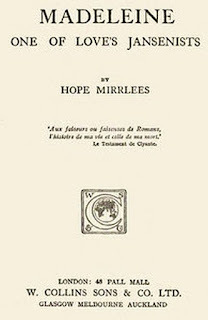
It remains to be seen if Madeleine is in any way similar to The Well; having, heaven help me, done an undergraduate essay on that wretched thing, I can say with confidence that no-one will ever have had occasion to describe anything by Hall as ‘modernism’s lost masterpiece’, as Julia Briggs did of 'Paris', The first few pages of Madeleine are not encouraging—perhaps I should have tried Mirrlees’ only other novel, The Counterplot , incidentally now in its centenary year of publication. Nevertheless, let us plough on.



